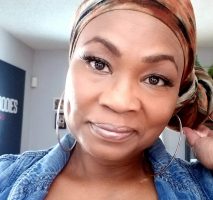Shelia, Cutaneous T-Cell Lymphoma Survivor
Shelia, Cutaneous T-Cell Lymphoma Survivor

My journey is an evolving one where my mind, heart, and views continue to grow. I have always been a determined person and learned early on in life to take ownership of my decisions. When I was 16 years old, I gave birth to my first child, and I will tell you that being a teen mother shaped me into the person I am today—for which I am eternally grateful. I got married, had my second child, and endured several difficult circumstances all before my 30th birthday. Having survived years of hardship, I made a vow to chase my dreams and live my life to the fullest. I went back to college and earned my MBA, watched my kids flourish, developed relationships, and indulged in activities that made me happy.
What I did not expect was for all of this to be challenged by a rare disease in the form of a rash all over my body. In 2006, I noticed the development of what appeared to be hives on my thighs and my back – raised spots that were red and itched like nobody’s business. I immediately made an appointment to see an allergist and after several tests, he recommended I seek a second opinion from a Dermatologist.
The dermatologist tested me for something he called “a rare skin disease.” While waiting for skin biopsy results, he referred me to another dermatologist who had more experience with African American patients. My biopsy test came back negative, and the hives seemingly went away with topical steroids. There were still no answers as to what was going on with my skin and I decided to mentally chalk the whole experience up to a fluke.
Life seemed to have returned to normal – that is until six years when I experienced another breakout. The rash was itchy, dry, red, and irritated. It got so bad that I had to change my sheets every other day due to the shedding of my skin. I was not in any pain, but I knew that something had to be wrong.
I went back to my allergist who thought I may be experiencing an issue related to my immune system and he advised me to once again go visit my dermatologist.
At the dermatologist, I noticed that there was a note in my file that read, ‘the patient should be tested for CTCL every 6 months.’ I asked the doctor to clarify as I did not know what CTCL stood for, and when I heard them say cutaneous T-cell lymphoma I was stunned. I did not know much about lymphoma at the time, but I knew enough to know that it meant cancer.
“At times like these, it can be extremely difficult to collect your thoughts and decide what to do next.”
At times like these, it can be extremely difficult to collect your thoughts and decide what to do next. I felt extremely lost, but I had a referral to see the head of dermatology at the Kansas City Medical Center in hopes that I could receive more definitive answers and solutions. My new doctor evaluated my skin, reviewed my previous medical records, and ordered a skin biopsy, a blood sample, and an MRI. The blood sample and the MRI confirmed my CTCL diagnosis.
There are some people who refer to CTCL as a chronic nuisance rather than a life-threatening illness as it is not as serious as some other types of cancer. However, for me, this disease was mentally debilitating. I felt constant anxiety from feeling trapped within my own body and my embarrassment pushed me to withdraw from my social life. I refrained from going out socially for a year to acclimate myself to avoid the constant questions that people would ask me. I often felt ostracized because of the social stigmas surrounding skin-related symptoms – it was exhausting. Fortunately, I had a wonderful team of doctors—a dermatologist and an oncologist—who worked together to provide me with an immediate treatment plan.
“I felt constant anxiety from feeling trapped within my own body and my embarrassment pushed me to withdraw from my social life.”
My treatment started with phototherapy (ultraviolet light used to decrease inflammation in the skin.) I got into what resembled a tanning booth, three times a week for three months. Unfortunately, the phototherapy used to address the external side effects was not enough for me. My doctors and I discussed that my increasing T-cell counts were cause for concern and they suggested I undergo additional treatment. This is when I became emotionally unglued. So far, I had been able to stay focused and keep my emotions in check, but this time I let the fear get the best of me, and I just cried.
Shelia Shares Her Story in a CTCL Facebook Live
I just kept thinking to myself, ‘what if this does not work? Then what?’ My doctor calmed me down, took my hand, and reassured me that everything would be ok. I wanted to believe him. I had to believe him! Since I had not responded to other therapies, my doctor suggested photopheresis therapy (a medical treatment that removes blood via a machine, isolates white blood cells, and exposes them to medication and UV light, before returning the blood to the patient.) My doctor told me that the treatment would work in conjunction with my own immune system and could help manage my CTCL. Initially, I had two treatments every other week and currently, I receive two treatments every eight weeks.
Ultimately, my journey with CTCL has been about accepting change and making choices. With every change in your life, big or small, there is no easy formula for making the right choice. However, I realized that for me to make the most informed and best decisions, I needed to take charge of my own life and be my own health advocate. Since my diagnosis, I have made conscious changes to my lifestyle to take better care of myself and I trust the strong communication I have with my doctors. I have learned to equip myself with the tools needed to live my life to the fullest, even while experiencing CTCL.
“Ultimately, my journey with CTCL has been about accepting change and making choices. With every change in your life, big or small, there is no easy formula for making the right choice.”

Being diagnosed with CTCL has certainly changed my life in ways I could have never imagined, including my social life and personal goals. It forced me to take a realistic look at my life and how I wanted to live it post-diagnosis. I could have taken on the “woe is me” mindset and allow CTCL to control my life or take on the spirit of a warrior and take control of my CTCL. I chose to be a warrior – to fight, to conquer, and to live successfully despite my CTCL. In doing so, I found a new and exciting way to manage my anxiety by producing a YouTube cooking show. This allows me to be creative, express myself, and give back to others. Whenever I feel a little down, I go straight to the kitchen and work on new recipes, new products, and new videos, all of which have a unique way of reminding me that I am a CTCL warrior.